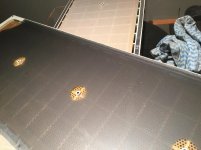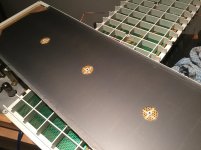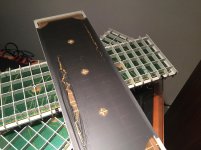I have a pair of later quad esl63. They have the newer panels. One speaker initiates the clamping periodically and basically prevents me from listening to anything at a more than quiet volume.
I assumed that it’s due to failing panels but I took off the grills and dust covers and the glue hasn’t failed at all on the stators. I can’t see the diaphragm so can’t see if there’s a rip. My question is, is it possible the clamp board components are failing and is this something expected or normal? I don’t want to remove all the panels to check the diaphragms as its a substantial job.
I assumed that it’s due to failing panels but I took off the grills and dust covers and the glue hasn’t failed at all on the stators. I can’t see the diaphragm so can’t see if there’s a rip. My question is, is it possible the clamp board components are failing and is this something expected or normal? I don’t want to remove all the panels to check the diaphragms as its a substantial job.
It could be a clamp board, but it's very common for the diaphragms to fail on the newer panels. They have something that I call "Diaphragm Rot" where the diaphragm develops a lot of little cuts and splits.
The clamp boards can fail in a couple ways. If they are overdriven, the TRIAC can fail and the speaker will be very quiet. However, on the clamp board is a filter capacitor for the power supply. This capacitor is 1000uF 16V, and the voltage it runs at is about 16V or sometimes a little higher. The high voltage doesn't do that cap any favors and they go bad. When they go bad, the clamp board get really touchy and triggers way too easily. Check that cap first.
You can check the panels, but disconnecting the high voltage from each panel, and bypassing the panel with an extra piece of wire.
Sheldon
quadesl.com
The clamp boards can fail in a couple ways. If they are overdriven, the TRIAC can fail and the speaker will be very quiet. However, on the clamp board is a filter capacitor for the power supply. This capacitor is 1000uF 16V, and the voltage it runs at is about 16V or sometimes a little higher. The high voltage doesn't do that cap any favors and they go bad. When they go bad, the clamp board get really touchy and triggers way too easily. Check that cap first.
You can check the panels, but disconnecting the high voltage from each panel, and bypassing the panel with an extra piece of wire.
Sheldon
quadesl.com
I can see a couple of little white circles on the diaphragms at the tops that look like mold growth
Ok I feel bad about this. I left this little project and then revisited it last week. Sheldon was absolutely right. It was that one capacitor that was preventing me f I’m enjoying my quads.
I was hoping someone might be able to help me now with a pair of 2905s I’ve got. How hard is it to remove the board? It looks like you can just unscrew four screws but does this give you access to the c28 capacitor. I have a similar problem with one speaker.
I was hoping someone might be able to help me now with a pair of 2905s I’ve got. How hard is it to remove the board? It looks like you can just unscrew four screws but does this give you access to the c28 capacitor. I have a similar problem with one speaker.
yes, you can unscrew the circuit board and lift it up to replace that cap. It's a bit tight.
However, given the vintage and the history of those panels, I'd say it's more likely that you have a bad panel (or more) than a bad power supply cap.
Sheldon
However, given the vintage and the history of those panels, I'd say it's more likely that you have a bad panel (or more) than a bad power supply cap.
Sheldon
Ok, I replaced that cap and the speaker is still distorting. The light is blinking at about once every 3 seconds very regularly though. The distortion appears to come from the mid panels and gets worse the louder the music. It also doesn’t go away when the power is unplugged.
Am I dealing with the dreaded failed panel(s) scenario?
Am I dealing with the dreaded failed panel(s) scenario?
Probably oone or two panels.
Look for loose stators.. or it could be a loose membrane.
Nothing to worry about.
Look for loose stators.. or it could be a loose membrane.
Nothing to worry about.
I checked the stators. They’re fine. I think I’m just going to have to take it apart.
Here’s a question. I have a spare esl63 with rebuilt brown stators. Will those sound ok if I use those as replacements? I know there will be an audiophile purity aspect that will be lost but really only concerned about sound.
Here’s a question. I have a spare esl63 with rebuilt brown stators. Will those sound ok if I use those as replacements? I know there will be an audiophile purity aspect that will be lost but really only concerned about sound.
I checked the stators. They’re fine. I think I’m just going to have to take it apart.
Here’s a question. I have a spare esl63 with rebuilt brown stators. Will those sound ok if I use those as replacements? I know there will be an audiophile purity aspect that will be lost but really only concerned about sound.
Here are some photos
1) The one with the spots is a mid panel
2) The clear one is the second mid panel
3) The destroyed one is a bass panel which I had bypassed
Attachments
The difference between series of panels is virtually non-existent. You will be fine with any of the white (or off white) support structure panels.
You most likely have diaphragm rot problems with your panels.
Sheldon
You most likely have diaphragm rot problems with your panels.
Sheldon
I didn't refresh before I replied, and I see you uploaded photos. Yup, that's diaphragm rot. Not sure what makes is so prevalent in the newer panels, but it is happening like crazy now. Expect to lose your others sooner or later, I'm sorry to say.
Sheldon
quadesl.com
Sheldon
quadesl.com
- Status
- Not open for further replies.
- Home
- Loudspeakers
- Planars & Exotics
- Quad ESL63 clamp detector


